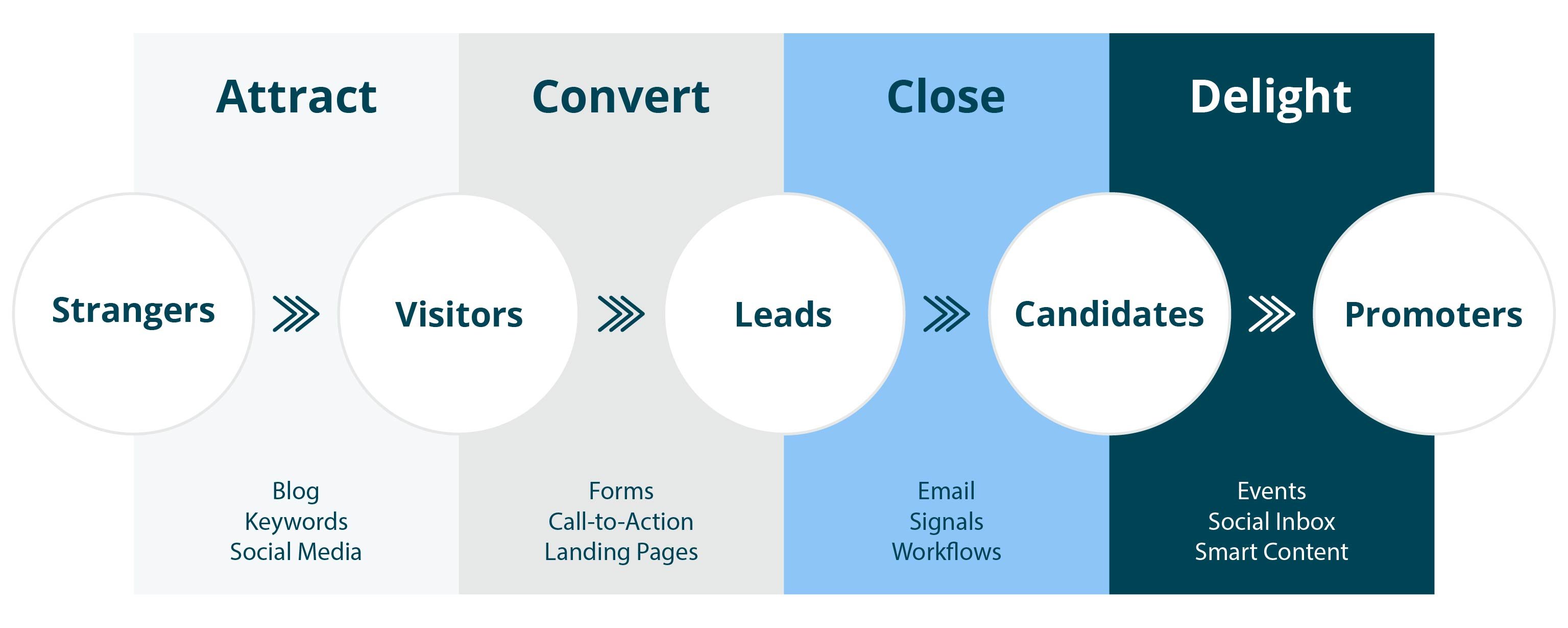How much does recruitment marketing cost? What are the key statistics for recruitment marketing?
Recruiting has become a major challenge for companies around the globe. The competition is fierce, and finding qualified candidates is becoming harder every day. To stand out from the crowd, recruiters need to adopt new strategies. One such strategy is using social media platforms to attract talent.
Recruitment marketing is a very important part of the recruitment process. The aim is to attract candidates who meet your requirements and then get them to apply for jobs through various channels. This means you need to advertise your vacancies widely and ensure they reach the right audience.
|
Inbound Recruiting |
What is inbound recruiting?
Inbound recruiting helps create a remarkable candidate experience by using employer branding and marketing strategies that help employers build relationships with top talent. Companies can take advantage of an inbound marketing approach by connecting with potential employees through social media channels, engaging with their networks, and delighting candidates throughout the hiring process.
Inbound recruiting is a great method for attracting talent and building relationships. By focusing on the candidate, you're able to establish trust and gain insight into their career goals. You'll learn things like why they want to change jobs, what motivates them, and what they look for in a workplace. This information helps you make better hiring decisions, and ultimately, improve retention rates.

Interesting Statistics About Recruitment Marketing
Today’s recruiters are leveraging data analytics to better understand their candidate pool and find them faster. Digital marketing tactics like social media, email and mobile apps play an important role in today’s recruitment process. Data plays an integral part in HR decision-making and recruitment processes.
This information helps determine if your recruiting practices are effective and, ultimately, whether they fill the positions you efficiently need with qualified candidates.
Whether it's time-to-fill or cost-per-hire, today's talent acquisition professionals use data and analytics to move and respond to challenges in a more agile, effective way. And this is where digital recruitment campaigns using job boards like LinkedIn or Glassdoor, networking events, social media campaigns, e-mail campaigns, geo-fencing, and other digital tactics help recruiters reach, connect, and hire today’s best talent.
Given that statistics are just one aspect of what's currently top of mind for today’s recruitment professionals, the question becomes: Which statistics drive their behaviour, methods, strategies and architectures? Data points help tell the story of what the current state of talent acquisition looks like and recruiters' efforts to find today's top talent.
In this context, let’s take a quick look at some interesting statistics regarding recruitment marketing and why these numbers should matter for any recruiter who wants to be successful.
1. Only 46% of recruiters see their job more as marketing.
Given the title and focus of the article, it makes sense that we begin with this state, but what's perhaps even more astounding than its mere existence is that it represents just under half of the total population. This means that more than half of today’s recruiters still don’t view a large portion of the job they do from a marketing perspective, meaning those who do have an advantage in today’s ultra-competitive marketplace. Because so much of today's workforce resides online and depends on user reviews (or employer testimonials) for feedback, social media interactions, or direct communication between a recruiter and candidate, it has turned out to be important for recruiters to take on more marketing-like jobs to find the best candidates for open positions.
Before proceeding further, let us ensure that it is not too late for you to start using these recruitment marketing statistics. Recruiters who want to truly disrupt their sandboxes can adopt a more marketing and employer-brand-focused approach rather than just waiting for resumes to land in their inboxes.
2. Of all professionals, about 75% are passive job seekers.
According to CareerArc, then that means approximately 75% of applicants relative to your industry are either not interested in changing careers or need to be heavily persuaded or incentivized to learn more about your organization and how what you can provide them in terms of benefits, empowerment, work-family balance, perks, or comparative advantages for their career path compared to their current employer/employee.
Recruitment marketing is where a robust recruiting strategy does the heavy lifting for you. To maintain an active social media presence, update your profile or company page, include relevant, engaging content, and ensure your website speaks to "what's in it" for potential employees. These efforts will spark interest among passive job seekers and ensure you stay top of mind when that person decides to actively enter the workforce.
3. One out of every ten new employees comes from social media.
According to a recent study by Clutch, one in ten new hires comes from social media interactions between recruiters and candidates. Given the proliferation of social media platforms in sales and marketing and employee brand strategy, it shouldn't be surprising that 10% of today's hires come through social media platforms.
Why do today's hires come from social media?
- Communication between a recruiter and an applicant is easier than ever before thanks to social media platforms like Twitter and Facebook.
- It used to be that by 5 pm, there were no more emails or messages for you to reply to. These days, potential job candidates expect recruiters to reach out to them via social media channels where they're most likely to be found.
- It doesn't cost anything to maintain an active social networking presence, so it is cost-effective. As an alternative to hiring recruiters for traditional recruiting purposes, companies can leverage social media to engage candidates directly.
- Referrals: Someone who knows you’re looking for a new job, tags you in an ad posted by a company where he/she thinks you might be interested. You browse the company's social media page, read their job posting, and submit an application for the position. As a recruiter, that's about 75% of the work they need to do to provide candidates with a front door into their organization.
4. Recruitment marketing can reduce your advertising spending by 50%.
With an effective recruitment management system in place, your recruiting channels are optimized to convert visitors into applicants, allowing you to spend less on advertisements for open positions. PageUp predicts that recruiting marketing can increase your advertising channels' effectiveness by 2X, allowing you to cut down on your advertising budget by half, saving you substantial amounts of cash.
Marketing campaigns with a low cost per lead (CPL) are generally desirable because they're targeted and engaging and can successfully convert large numbers of visitors into leads. However, marketing campaigns with a high CSL are generally undesirable because they're not optimised to reach their target audience, or they don't have a compelling call to action (CTA).
When recruiting, the same principles apply as when advertising. If your career sites or job boards are not optimized for conversion, your cost per application (CPA) will be high. If they're optimized for conversion, your CPA will likely be lower.
5. More budget is being allocated to Recruitment Marketing.
Practitioners anticipate increasing budgets for the coming year by 25% to 35%.
Many companies are now seeing the clear-cut benefits of Recruitment Marketing (defined as using marketing strategies to promote the company’s value to attract, hire, and retain talent).
One of the reasons why companies spend more on recruitment marketing than they used to is because there's an increased demand for top talent. As a result, companies must invest more in recruiting marketing to attract top candidates.
Regardless of whether you spin it one way or another, recruitment marketing budgets are increasing. Use this data as evidence to ask for higher budgets within your organization, stressing that it’s essential if you want to stand out from your competition, especially since job advertising alone isn't enough to attract top talent nowadays.
6. Employees are 3X more trusted than employers.
According to LinkedIn, employees are trusted three times more than companies when it comes to messaging. So, if you want to recruit people for your business, then testimonials from current staff members, reviews on websites like Indeed and Glassdoor, and any referral-marketing-based strategy where employees refer others to your business hold much more weight than any content you can create yourself.
However, this means that when recruiting for jobs, you should focus on hiring people who already know you and your company well enough to tell their own stories about why they want to work at your company. You should rely on authentic photos and video content, rather than glossy ones because these types of content show real-life examples of your culture and values.
Sources
Page Up People, Rally Recruitment Marketing, Aspiration Marketing, Clutch



